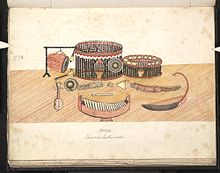Hsaing waing
However, these ensembles do not employ the use of a drum circle like the pat waing.The earliest pictorial evidence of the hsaing waing ensemble dates to the 1600s, coinciding with the Burmese invasion of the Ayutthaya Kingdom, which may have introduced additional instruments, principally a gong chime called kyi waing.
[3] However, the Burmese hsaing waing differs greatly in its diversity of instruments and musical style from Thai folk ensembles.
[5] The hsaing waing ensemble includes a variety of percussion and wind instruments, including various gongs and drums:[6] For more formal and classical performances, the ensemble may be accompanied by the saung gauk, the Burmese harp; the pattala, a Burmese xylophone; or the piano and violin, both of which were introduced during the colonial era.
[7] Music from the hsaing waing ensemble accompanies singing, dancing, and dialogues in all types of theatrical performances.
[8] Music of the hsaing waing is characterized by dynamic, lively and sudden contrasts and shifts in rhythm, melody and tempo.



